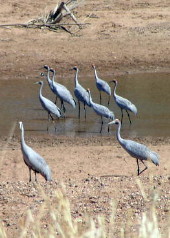- «Fences Intro |
- «Fences 1 |
- «Fences 2 |
- «Fences 3 |
- 4 Whiteboard
4 The Whiteboard
Here's some of the comments up on the Ozcranes ‘Fencing Whiteboard’, with brief responses. The Whiteboard is a staging point for ideas from farmers and agricultural advisers, about fencing and wetland grazing in many different situations. New material will be added to the Crane-friendly Fencing Guide or other parts of the site, as we research the issues and add links to helpful sites. Feedback is welcome, to help us develop or respond to these issues.
Crane behaviour and safety
Many significant crane sites are modified or artificial wetlands, created by pastoralists for stock watering (E Duignan, Upper Herbert, N Qld)

COMMENT
“Underwater fencing is a problem for cattle but shouldn't be a problem for cranes, cranes don't use deep water, so can see the fence”
RESPONSE
Brolgas and Sarus Cranes nest in water to 600mm, with some long vegetation. Where seasonal rains damage fences, wires sag, the fence is less visible, and there can be risks especially to birds trying to take off or land, but also to immatures swimming or walking through wetlands before fledging
COMMENT
“Fences could have narrow gaps like those that exclude cattle but allow kangaroos or emus through, as in W.A., if Brolgas learnt to use them”
RESPONSE
An interesting idea, adult Brolgas have been seen walking through fence gaps to reach water. There's another observation of a young Brolga disturbed while feeding with its parents near a fence, they flew over while the young ran up and down the fenceline apparently looking for a gap.
COMMENT
“Graziers accept an annual loss factor of (say) 3% as normal for cattle – is crane entrapment likely to be more? i.e. can the crane population stand some accidental kill?”
“Sarus Cranes and Brolgas are not endangered species so this is not a sustainability issue”
RESPONSE
In southern Australia, the only area where we have good population figures, there are less than 1,000 Brolgas, with few young produced each year and little or no connections with northern Brolgas. In this situation, every avoidable loss is one too many for southern Brolgas. There are at least 3,000 Australian Sarus Cranes but the recruitment level is also low. Arguably ‘environmental fencing’ should have a no-risk policy on entrapment for large waterbirds, part of the biodiversity (and ‘sustainability’) the fencing is supposed to protect. For management fencing, there will always be trade-offs and Ozcranes is hoping discussions like these will lead to cost-effective alternatives to risky materials, and better positioning of wetland fencing.
Water and paddock management
↓ Cattle pugging at unfenced dam, Gulf Plains, NW Queensland (Swati Kittur)

COMMENTS
“Re crane safety in the Wet (breeding) season, cattle should not need to be excluded in the Wet for environmental reasons (as distinct from management reasons) – there is so much water around, no one area should be over-pressured”
“Small natural waterholes and farm dams are under most pressure in the late dry. With trampling and pugging, stock as well as kangaroos and other animals get bogged – strong fencing including barb wire may be essential. Or, depending on the location of feed, more water points may relax pressure on each particular source”
“Rather than fencing close to waterholes it's possible to fence wider paddock areas (with wetlands or dams in them) and rotate cattle. Or, wetlands or dams can be fenced into areas where grazing is intermittent like holding paddocks, mustering lanes, crash-grazed firebreaks”
“A combination of shut out and one-way trap gates (as used to aid mustering by self-yarding – ‘Hirst short-arm are as good as any’) could be used where water sources are under stress”
RESPONSE
A clear theme of the fencing discussion for production properties, is that good wetland management can be integrated with good paddock and stock management and fences need not necessarily be placed immediately around water sources. A planned grazing program should also help keep crane habitat (breeding and non-breeding) free of dense rank vegetation growth.
COMMENT
“Feral pig fencing is just not feasible in minimal surveillance areas, there is too much maintenance”
RESPONSE
Feral pig control or exclusion is inevitably both expensive and controversial. It's unclear how much damage pigs do to cranes or their habitat, eg pigs may trash small remnant waterholes that cranes depend on in dry seasons, but it has been argued that pig diggings actually advantage some crane food plants.
Property management issues
COMMENTS
“Many small, and some larger ‘wetlands’ targeted for environmental fencing exist only because of grazing management ie they are constructed by landowners or managed to provide all-year water”
“For business costs there are differences between (1) new or replacement fencing purely for environmental reasons (2) new or replacement fencing for management reasons (including repairs)”
Feedback
Comments and suggestions on Crane-friendly Fencing are welcome, contact details here».






